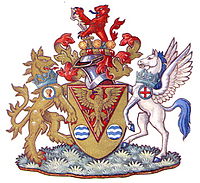Municipal Borough of Uxbridge facts for kids
| Uxbridge | |
 Uxbridge within Middlesex in 1961 |
|
| Geography | |
| Status | Local board of health (1849 - 1894) Urban district (1894 - 1955) municipal borough (from 1955) |
| 1894 area | 868 acres (3.5 km2) |
| 1965 area | 4,143 acres (16.8 km2) |
| History | |
| Created | 1849 |
| Abolished | 1965 |
| Succeeded by | London Borough of Hillingdon |
Quick facts for kids Demography |
|
|---|---|
| 1901 population | 8,585 |
| 1961 population | 63,941 |
 |
|
Uxbridge was a special area in north west Middlesex, England. It had its own local government from 1849 to 1965. The main town for this area was also called Uxbridge.
Contents
The History of Uxbridge's Local Government
How Uxbridge Got Its Own Council
Uxbridge was one of the first towns in England to get its own local council. This happened in 1849. It was formed under a law called the Public Health Act 1848. This law helped towns manage things like clean water and waste. The first council was called a local board of health.
Later, in 1894, the local board became an urban district. This meant it had more power to manage the town. The Uxbridge Urban District Council met in the Uxbridge Courthouse. In 1955, the urban district became a municipal borough. This gave it even more importance and a special charter.
Changes to the Uxbridge Area
When it first started, the Uxbridge district included the areas of Uxbridge and Hillingdon West. In 1929, the district grew bigger. It added more areas like Cowley, Harefield, Hillingdon East, and Ickenham. These areas used to be part of the Uxbridge Rural District.
In 1938, all these smaller areas were combined. They formed one large area called the Uxbridge parish. This new parish covered the same land as the whole district. In 1955, this combined area officially became a borough.
Becoming Part of Greater London
The Uxbridge borough continued until 1965. At that time, it was changed again. Its area became part of Greater London. It helped form a new, larger area called the London Borough of Hillingdon.
Understanding the Uxbridge Coat of Arms
What is a Coat of Arms?
A coat of arms is like a special symbol or badge for a town or family. It uses pictures and colours to tell a story about its history. The Uxbridge borough was given its own coat of arms in 1948.
Symbols and Their Meanings
The coat of arms has many interesting symbols:
- The pile (a pointed shape) comes from the old Basset family.
- The two fountains (blue and white circles) represent the rivers in the district.
- The eagle comes from the Paget family. They were Earls of Uxbridge. It also reminds us of the important RAF Depot and Northolt Airport nearby.
The top part of the coat of arms, called the crest, also has symbols:
- The chrysanthemums (flowers) show that growing flowers was important in the town.
- The lion holds a seax, which is an old Saxon sword. This sword is also on the coat of arms for Middlesex County.
The animals on the sides, called supporters, are also meaningful:
- The tiger comes from the Marquess of Anglesey's family symbols.
- The Pegasus (a winged horse) further represents Uxbridge's link to the Royal Air Force (RAF).
- The green astral crowns refer to the Green Belt around the town. This is a protected area of countryside.
- The wheatsheaf (a bundle of wheat) shows the importance of brewing, growing corn, and corn trading.
- The red cross is from the City of London's coat of arms. It connects Uxbridge to Greater London.
Today, the coat of arms of the London Borough of Hillingdon uses some of these symbols. It includes the heraldic tiger, the red lion crest, and the eagle from the old Uxbridge borough.

